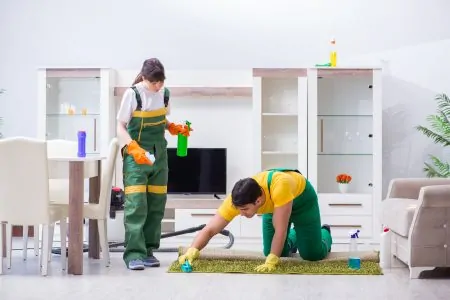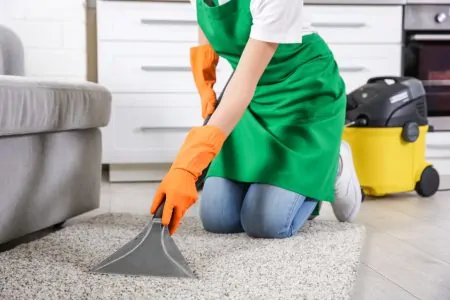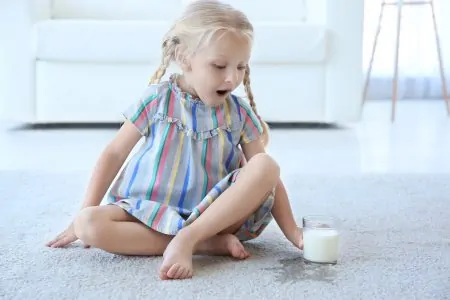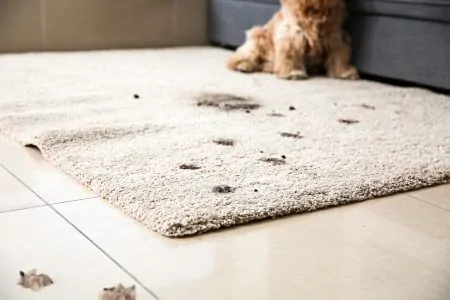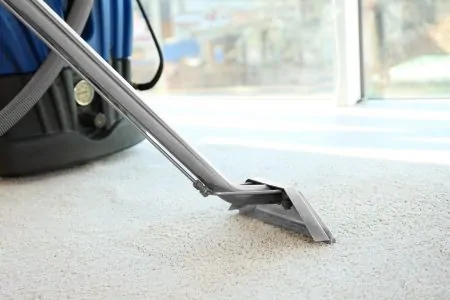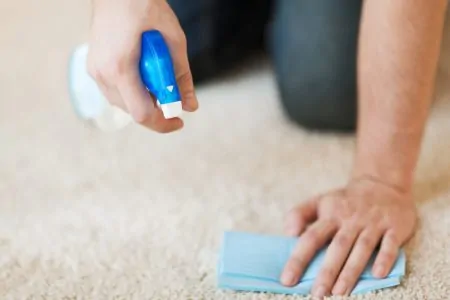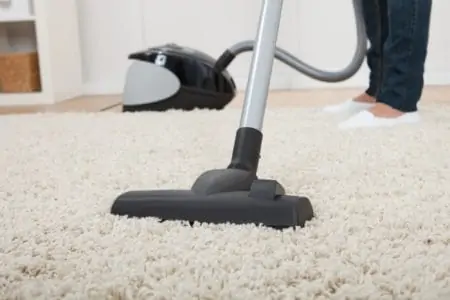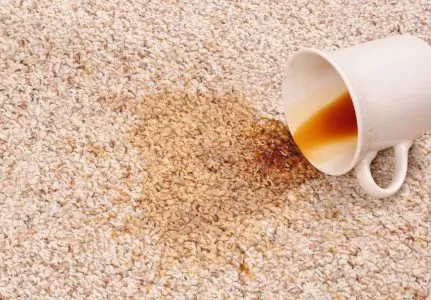While carpets are famous for making your home feel cozy, they are also a place where dust mites gather. These, in turn, can trigger asthma and allergies. Therefore, we advise vacuuming weekly, and in addition, to deep-clean the carpet every month (1).
If you want your carpet cleaned professionally, you’ll be thankful, but also a bit out of pocket.
If you’re wondering how much does carpet cleaning cost, we’ve got prices and more information to help you make a decision.
Key Takeaways
- Professional carpet cleaning costs average $0.27 per square foot or $40-$70 per room, with most people paying between $120 and $240.
- Additional costs may apply for stain removal, repairs, furniture moving, stairs, and special treatments like Teflon or organic cleaning.
- Common professional cleaning methods include hot water extraction, dry cleaning, encapsulation, shampoo, and bonnet cleaning.
- To maintain a clean carpet, vacuum regularly, use stain-resistant treatments, and avoid wearing dirty shoes indoors.
How Much Does Carpet Cleaning Cost?
Professional carpet cleaning companies will usually charge based on the size of the area that requires a deep cleaning or per room.
The average cost of cleaning a square foot of carpet is $0.27, while a room is between $40 and $70 (2). Depending on the size of the home, most people pay between $120 and $240, so on average, $180 (3).
| Average cost per square foot. | $0.27 |
| Average cost per clean. | $180 |
| Average cost per room. | $40–$70 |
| Average cost for 200–500 square foot home. | $45–$180 |
| Average cost for 500–1500 square foot home. | $180–$540 |
| Average cost for 1500–2500 square foot home. | $540–$900 |
Carpet Cleaning vs. Rug Cleaning
While a carpet must be cleaned at your house, a rug is easy to take elsewhere. Professional rug cleaners will pick up the rug from your home and take it for a thorough cleaning. You can also deliver your rug to specialized cleaning companies. A rug of 8 x 10 feet will cost you around $320 for professional cleaning (4).
Additional Carpet Cleaning Costs
The above estimated costs just take the general cleaning into consideration. However, you might want extra cleaning for spots, repairs, or help with moving furniture. These are all extra services that lead to additional costs.
Extra Cleaning
You may need extra cleaning for several reasons:
- Pet stains: Not all pets are house-trained, so they might relieve themselves on your carpet. A professional carpet cleaner will pre-treat the stains before the general cleaning of the whole carpet. This will also help reduce any bad odors accompanying this type of stain.
- Bloodstains: It’s best to remove them as soon as they happen because they might not come out later. Apply some cold water, spray with a solution of detergent and cold water, and repeat if needed. Never use hot water because it can set the stain.
- Coffee stains: These also have to be removed immediately. Shops sell specific products that fight against these stains. But, if you don’t have any at hand, you can use a mixture of water, vinegar, and light bleach. Always blot when cleaning the stain; don’t rub.
Stains can cost anywhere between $40 and $300 to remove, depending on the severity and size.
Repairs
Your carpet should last you at least 10 years. However, some factors can speed up the degeneration process. Fibers can be damaged by excessive sunlight, high foot traffic, bleach, and stains. This fiber damage can eventually lead to discoloration.
Professional carpet cleaners can apply color repairs, also known as dyeing. They dye the carpet again with a mixture of the original carpet’s paint and other materials. Once it is redyed, the life span of the carpet is extended.
Consider carpet treatments that create resistance against stains. This way, you can try to avoid the process of discoloration. Some products to invest in include Teflon, Scotchgard, and Stainmaster.
The loosening of the carpet can cause additional damage to your carpet. This can cause waves and ripples in your carpet, which signal a need to re-stretch. Carpets can loosen for many reasons, such as steam cleaning the wrong way or false installment. We recommend getting in touch with professional carpet cleaners and installers for these reasons.
Furniture
- Moving: Your carpet is probably covered by several pieces of furniture — some heavier than others. Most professional cleaners will charge extra to move your furniture (the cost may depend on weight). Others, though, may include it in the price. With all these different possibilities, it’s good to check beforehand. If you’d like to save costs, you may move the furniture yourself before the cleaning.
- Cleaning: Some professional carpet cleaners offer a package where furniture cleaning is included. This can often save you the extra cost of having another company come and clean the furniture separately. So ask your cleaner to see what the offers are.
Stairs
As this cleaning takes a bit more effort, many professional carpet cleaners include an average extra cost of $3-5 per stair.
Teflon Treatment
This is one of the treatments you can do — or let professional carpet cleaners do — to pre-treat your carpet. Teflon adds a stain- and water-resistant coating to the carpet, which gives you more time in case of spills.
Organic Cleaning
If you prefer a 100 percent eco-friendly cleaning with non-toxic products, several companies offer this. The average cost per room is around $165.
What’s the Best Method for Cleaning Carpets?
There are different types of carpet cleaning. Each type comes at its own cost and uses different cleaning techniques.
Hot Water Extraction (HWE)
This is the most often used technique. Under high pressure, hot water is applied to the carpet. Simultaneously, a grooming tool scrubs the carpet to loosen the dirt inside of it.
In some cases, an ammonia solution is added. After this, the carpet is rinsed with hot water. This water is then suctioned back into the machine.
Clearly, this method uses a lot of water. Therefore, you must suction out most of the water again to avoid mold growth inside the carpet fibers. So, your carpet will need 24 hours to dry after this cleaning treatment.
This method can cost around 30 percent more for cotton and wool carpets as they are more challenging to clean. The more loops in the carpet and the more twisted they are, the more it will cost.
Dry Cleaning
Also known as dry moisture cleaning, this type of carpet cleaning uses much less water than the HWE method. Chemicals and cleaning powders are mixed with hot water and brushed into the carpet. After this, the carpet is vacuumed.
With this method, your carpet only needs to dry for 20 minutes before you can walk on it again. Dry cleaning is less labor-intensive than HWE cleaning, but it’s also less effective. So don’t be surprised to find that less dirt and debris are removed.
Encapsulation Carpet Cleaning
This type of cleaning is not that different from dry cleaning. A mixture of cleaning products is rubbed into the carpet by a machine. This can either be a rotary machine, a brush applicator, or a compression sprayer. The added detergent binds to the debris and dirt inside the carpet before being vacuumed again.
After this type of cleaning, you can walk on the carpet immediately. If your carpet isn’t that dirty, it’s an excellent method to improve its appearance. However, on a heavily soiled carpet, this type of cleaning is less effective.
Shampoo Carpet Cleaning
This technique doesn’t require much drying because a low amount of moisture is used. The carpet shampoo foam is brushed into the carpet through rotation and then vacuumed.
It’s worth noting that the product might leave some residue in the carpet as it is not rinsed. This is also the downside of this method, as the residue might attract more dirt in the future.
Bonnet Carpet Cleaning
This is a surface-cleaning method mostly used in hotels and commercial buildings. A rotating pad is soaked with cleaning products and attached to a machine. This device is then pushed over the carpet at 100–300 rpm.
Every few hundred square meters, the pad must be treated again with extra solution and rinsed to ensure its efficiency. Otherwise, it just fills up with the dirt of the carpet, which is afterward spread out on the whole carpet. As this is not a deep-clean, it might have to be repeated more often.
Carpet Types
The price of cleaning can vary per type of carpet. With more delicate materials, there will be a price increase. Let’s take a look at the most common materials carpets are made of:
- Nylon: The most popular material for producing carpets. They can be cleaned with the cheaper hot water extraction technique. A downside to this fabric is that it stains easily and might need cleaning more often.
- Olefin: This material is resistant to mold. It’s also stronger than nylon but performs less than other fibers. It has a wool-like appearance and good stain-resistance. Its soil-resistance, however, is very poor.
- Acrylic: This is a cheaper alternative to wool. It’s soft, delicate, and luxurious with good stain-resistance.
- Wool and cotton: These types of carpets are made from natural materials. They tend to be durable, stain-resistant, and eco-friendly. The disadvantage of wool and cotton is that they’re more expensive as a material as well as to clean.
How Are Carpets Professionally Cleaned?
Most professional carpet cleaners will follow these steps:
- Pre-inspection: The cleaning company will probably send an employee to check your carpet. They inspect possible stains and the type of carpet you have to estimate the expected price. Sometimes this pre-inspection is done over the phone. If that’s the case, make sure you check your carpet for spots before making the call.
- Removal of furniture: You can do this yourself, or you can ask the cleaning company. Small furniture will be removed, while bigger pieces might have to remain in place. In that case, they will be covered for protection. The furniture should only be returned once the carpet is dry — the duration depends on the type of cleaning.
- Pre-vacuum: The carpet gets the first vacuum to remove any dry dust and dirt out of the carpet.
- Pre-spray and pre-spots: The carpet is sprayed, with stains given special attention. This treatment increases the effectiveness of the cleaning process.
- Cleaning: The whole carpet area will be cleaned depending on the method your carpet needs. The soil is extracted from the carpet, and if needed, the carpet is thoroughly rinsed.
- Post grooming: Some companies apply this grooming. This helps the carpet dry faster and in the correct way.
- Dry: The time your carpet needs to dry depends on the method used to clean it. If this is a long time, professional carpet cleaners can use ventilators to speed up the process. These draw in the room’s dry air and push it towards the carpet. It also helps if you open your windows and put on the AC or fans.
- Post-cleaning inspection: After cleaning, an employee will join you to check the carpet. You can point out anything not to your liking.
Can I Clean My Carpets Myself?
Especially for cleaning stains, some DIY techniques can be effective as well. You can use some household products such as baking soda to create your own stain removers.
Some stains, however, will not be removed easily. You can try to get them out with a machine. Many local home improvement stores offer them for rent. Renting costs start at $30 per day. Most of these rental venues will also provide a cleaning solution to use with the machine.
Is Professional Carpet Cleaning Worth It?
You may think of getting carpets professionally cleaned as a hassle, especially since they will only get dirty again. But DIY is not always the easiest or cheapest option.
DIY Downsides
Some cleaning tasks don’t require professional carpet cleaners. But DIY carpet cleaning can’t cover everything. The downsides of hiring a machine yourself are:
- Difficult to use: If you are not used to operating heavy machines, it might be hard for you to move them around. This is especially so if you have a small living space. Unfortunately, it doesn’t help that these machines often come with difficult instructions.
- Malfunction: Others have rented the material before you and might have misused it. This might cause the machine to break, leading to additional costs or damaging your carpet.
- Wrong size: Depending on your carpet surface, a professional carpet cleaner will bring a machine with the necessary size. When renting yourself, you might end up with a device that’s too big or too small. This might result in a longer working time.
Professional cleaners might be more expensive, but they know what they’re doing. They have the exact materials needed and can change their methods depending on the type of your carpet. The price difference might be worth it as the effort you have to make for DIY is high.
How to Choose Your Cleaner
Before making your choice, do some research on the different cleaning companies in your neighborhood. Ask them the following questions:
- How much experience do they have?
- What kind of methods do they offer?
- Do they have any packages and offers? (e.g., for furniture cleaning)
- What is the cost?
- What are the additional costs?
Care Tips
To try and keep your carpet clean, follow these tips:
- Vacuum your carpet two to three times per week.
- Apply a stain-resistant spray or treat your carpets with a protective solution.
- Avoid walking with dirty shoes on the carpet so debris doesn’t become stuck in it.
- Check if rugs lose their color when they become wet before putting them on your carpet.
- Don’t wait until your carpets look dirty to clean them — the dirtier your carpet, the more it will cost you to clean it.
FAQs
Count the Cost
When planning your carpet’s monthly cleaning, there are many things to consider. The size of the room will influence the price a professional cleaner will charge you. So when choosing a type of flooring for your home, you can examine first what the estimated costs would be.
You now have an overview of any additional costs. With spills, you now know how to clean them with standard household products. This prevents spills from turning into stains that require a professional clean.
While DIY carpet cleaning is always an option, the amount of work doesn’t always weigh up against the cost of professional cleaning.
